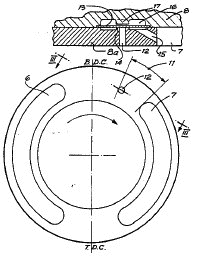| |
| Quiet Hydraulics |
Somehow it has happened that I have had an abiding interest in making hydraulic systems quieter through nearly all of my working life. The biggest challenge is to make a high pressure variable displacement pump silent over all of its operating range; not yet achieved, but still working on it. The goal is to find the hydraulic equivalent of a helical gear over a spur gear.
There are many aspects to quiet operation, from basic rigidity of components, geometry and so on, but the most important issue in piston pumps is the timing at the port face.
The Point Nine Pump
My first involvement was in the development laboratory of R.J. Ifield and Sons Pty Ltd at Dural, NSW, 1968, meticulously modifying, testing, modifying, testing, modifying, testing port face notches of a piston pump. An exercise in frustration with too many variables and the difficulties of sound level measurement and assessment. We found an answer. We certainly proved that having timing notches was better than none. But the answer was only quieter - not silent.
The next step was working as designer under Dick Ifield at his home office at Beecroft, 1970, on a fixed displacement pump called the Point Nine because its piston diameter was 0.9 inches. While I was doing the design iterations of the mechanics, the master was carrying out incredibly tedius calculations of the timing notches, doing a series of simulation runs taking fluid compressibility, pump volume change and instantaneous notch area into account - using a slide-rule! I was mightily impressed, and forever changed, by this willingness to take infinite pains to achieve a result – it took weeks to finalise the notch design.
The end result was pretty good. The unit was independently tested at the University of Eindhoven, Netherlands, and found to be a “most interesting unit with the highest efficiencies yet to be measured in pumps of this kind” and “remarkably quiet in operation”. But again it was quieter, not silent.
| 3.5T
Transmission Then back to Dural, where my first real try at the “infinite pains” was to optimise the timing for the 3.5T transmission being designed and built as an automotive development transmission under a USA DOE contract. This design also incorporated the Reed Valve, US Patent 4,540,345, which provides increased flexibility in the use of precompression to reduce timing noise. By this time
we had acquired an HP85 computer, an early
all-in-one BASIC machine that was luggable for those with strong arms
and not enough sense. This did not make the job any quicker, partly
from the need to develop a simulation program from scratch, but mainly
because it allowed for better optimisation by making more trial and
error simulation runs. |
|
| I would take it home each
night and set it up for a run, to be woken up by the built-in printer
firing up in the early hours of the morning. The end result was pleasing, with a measured 8 to10 db reduction in noise compared with a Sundstrand 20 transmission of the same size. It sounded almost pleasant, like a large sewing machine, but still some way from silent. Step by step The same simulation approach was used for many development units, some using 5/95 fire resistant fluids. A software package called Extend replaced the home-grown code used on the HP85 and imported into bigger computers as they came along. I still use Extend nearly 20 years later. |
 |
The early simulation work concentrated on providing a smooth transition of pressure in the pump cylinders as they crossed from the high pressure port to the low pressure port and then back to the high pressure port again. Using precompression and decompression it was possible to make a quiet pump for a single point of speed, pressure and displacement; the trick being to chose the quiet point so that the noise was acceptable over the full operating range. Looking at the timing notch designs of modern hydraulic pumps, it is obvious that all manufacturers now use a similar approach, no doubt each with their proprietary enhancements. Pumps are quieter than they used to be, but still far from silent. The reed valve made it possible to make quiet over a small range of conditions, pretty good with a fixed displacement unit, but not effective at small displacements and high pressures. A second factor was introduced into the simulation optimisation called “Jet Impact”. This worked on the concept that the pump noise was a hammer and bell situation, where an event produces a hammer action which is then picked up and amplified by the fluid volumes and mechanical bits that make up the pump. A hammer effect is created by a sudden change in jet force, as defined by the opening area of the notch and the pressure drop across it. This analysis technique provided a small but significant improvement. |
|
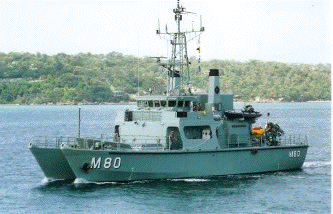 HMAS Rushcutter Inshore Minehunter
During the late 1980’s, a concept for an inshore mine hunter was developed in Australia for the Royal Australian Navy using small catamaran vessels. Two ships were built, HMAS Rushcutter and HMAS Shoalwater. They were not very successful operationally and have been recently decommissioned. |
|
The
original drive system was provided by Dowty UK consisting of a
fixed displacement drive motor with low magnetic signature and a
variable displacement pump. The pump proved to be expensive with
reliability problems, so a decision was made to try a commercial
Denison pump; it proved to be too noisy and I was asked to suggest
means to make it quieter.
The approach I recommended was to redesign the timing to minimise the noise at source, then look at accumulators and such to further reduce the noise levels if required. |
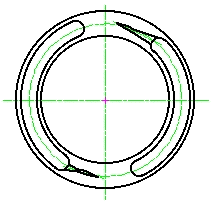 |
Ford HPA Vehicle SAE Paper 2002013128 “Hydraulic Power Assist – a Demonstration of Hydraulic Hybrid Vehicle Regenerative Braking in a Road Vehicle Application” by R. P. Kepner of the Ford Motor Company describes the application of an Ifield pump and valve system in a SUV, with useful improvement in fuel economy. This pump is essentially of my design, including the timing. The noise level was knocking on the door of acceptability – “With further development the noise level and quality can be acceptable for commercial markets.” Again, not silent. |
|
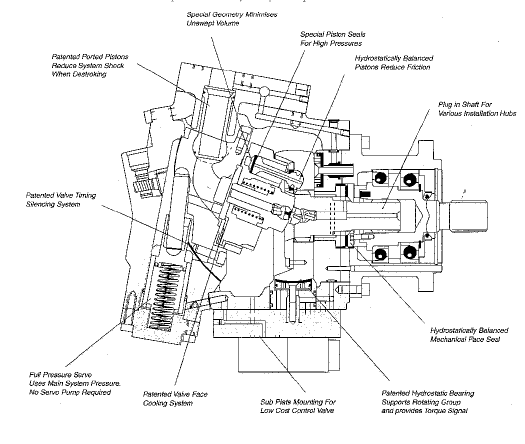 |
|
| Coastal Minehunter The Royal Australian Navy has six Huon Class minehunters based on the Italian Gaita, but manufactured by ADI in Newcastle, NSW. They have a dual propulsion system; a conventional diesel drive with variable pitch propellor for normal travel; and three fuly azimuthing hydraulic propulsion units from Cazoni S.p.A of Bologna, used when mine hunting. |
|
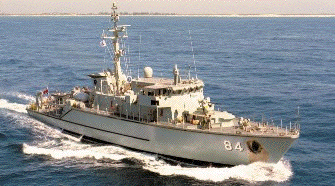 HMAS Norman - Huon Class Minehunter |
|
| At least in part due to my good result
with the Estuary Minehunter, I was asked to assist with a problem of
noise from the propulsion motors interfering with the very sensitive
sonar system. The investigation and solving of this problem took a fair
bit of time, money and many trips to Bologna, but was ultimately very
successful, with the complete removal of the interference. The figures show the before and after noise traces, measured by a hydrophone mounted in the case of the hydraulic motor. |
|
 |
|
| From my point of view this was a
watershed result because, for the first time, we had a silent hydraulic
motor. I will always remember standing at the test rig in Bologna,
stethoscope and all, and listening to a silent piston motor for the
first time in my life. The Future A fixed displacement motor driving a propellor with a unique speed/pressure curve is relatively easy to work with, so the challenge is to take that new understanding and extend it to cover a full range variable displacement pump. So far success eludes, quieter but still not quiet – but the journey is not yet over. I have a small development laboratory where I am researching many possibilities, in my own time, with my own money, real backyard shed engineering. Wish me luck. |
|
